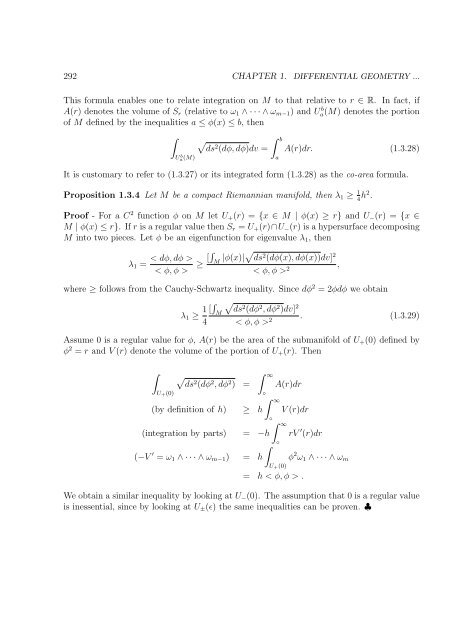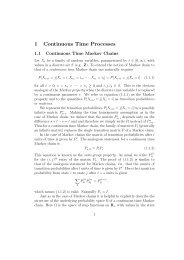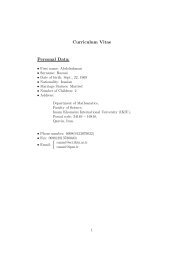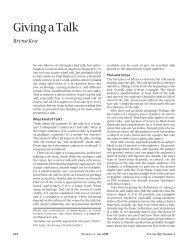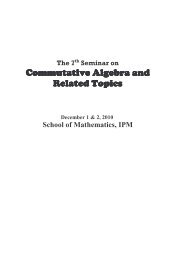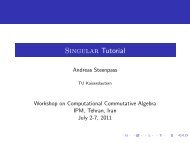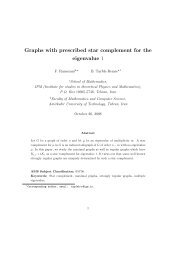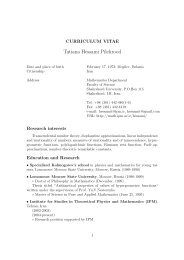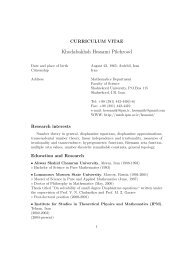Chapter 1 DIFFERENTIAL GEOMETRY OF REAL MANIFOLDS
Chapter 1 DIFFERENTIAL GEOMETRY OF REAL MANIFOLDS
Chapter 1 DIFFERENTIAL GEOMETRY OF REAL MANIFOLDS
Create successful ePaper yourself
Turn your PDF publications into a flip-book with our unique Google optimized e-Paper software.
292 CHAPTER 1. <strong>DIFFERENTIAL</strong> <strong>GEOMETRY</strong> ...<br />
This formula enables one to relate integration on M to that relative to r ∈ R. In fact, if<br />
A(r) denotes the volume of Sr (relative to ω1 ∧ · · · ∧ ωm−1) and U b a(M) denotes the portion<br />
of M defined by the inequalities a ≤ φ(x) ≤ b, then<br />
<br />
U b a (M)<br />
ds 2 (dφ, dφ)dv =<br />
b<br />
a<br />
A(r)dr. (1.3.28)<br />
It is customary to refer to (1.3.27) or its integrated form (1.3.28) as the co-area formula.<br />
Proposition 1.3.4 Let M be a compact Riemannian manifold, then λ1 ≥ 1<br />
4 h2 .<br />
Proof - For a C 2 function φ on M let U+(r) = {x ∈ M | φ(x) ≥ r} and U−(r) = {x ∈<br />
M | φ(x) ≤ r}. If r is a regular value then Sr = U+(r)∩U−(r) is a hypersurface decomposing<br />
M into two pieces. Let φ be an eigenfunction for eigenvalue λ1, then<br />
λ1 =<br />
< dφ, dφ ><br />
< φ, φ ><br />
≥ [<br />
M |φ(x)| ds 2 (dφ(x), dφ(x))dv] 2<br />
< φ, φ > 2<br />
where ≥ follows from the Cauchy-Schwartz inequality. Since dφ2 = 2φdφ we obtain<br />
λ1 ≥ 1 [<br />
4<br />
<br />
ds2 (dφ2 , dφ2 2 )dv] M<br />
< φ, φ > 2 . (1.3.29)<br />
Assume 0 is a regular value for φ, A(r) be the area of the submanifold of U+(0) defined by<br />
φ 2 = r and V (r) denote the volume of the portion of U+(r). Then<br />
<br />
<br />
ds2 (dφ2 , dφ2 ) =<br />
∞<br />
A(r)dr<br />
U+(0)<br />
◦<br />
∞<br />
(by definition of h) ≥ h V (r)dr<br />
◦<br />
∞<br />
(integration by parts) = −h rV<br />
◦<br />
′ (r)dr<br />
(−V ′ <br />
= ω1 ∧ · · · ∧ ωm−1) = h<br />
φ<br />
U+(0)<br />
2 ω1 ∧ · · · ∧ ωm<br />
= h < φ, φ > .<br />
We obtain a similar inequality by looking at U−(0). The assumption that 0 is a regular value<br />
is inessential, since by looking at U±(ɛ) the same inequalities can be proven. ♣<br />
,


